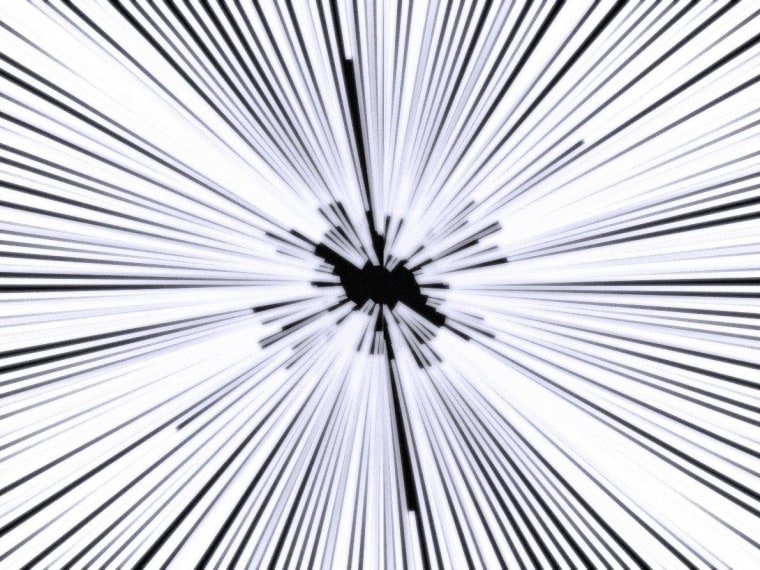In the "Star Wars" saga, the Millennium Falcon's jump to hyperspace is totally fictional — but if it could happen, some enterprising physics students in Britain say that it wouldn't look anything like the stretched-out beams of light shown on the movie screen. Instead, Han Solo would see a disc of bright light right in the middle of his windshield, representing the blue-shifted afterglow of the big bang. He'd also get a killer jolt of X-rays.
Those are the claims laid out in a paper on relativistic optics written by four physics students at the University of Leicester: Riley Connors, Katie Dexter, Joshua Argyle and Cameron Scoular. The paper is published in the university's Journal of Physics Special Topics.
The journal features scientific investigations into some of the more, um, unusual questions of physics. For example, could Batman really use his bat-cape to glide through the skies? (Yes, but the landing would almost certainly kill him.) Could James really use a flock of seagulls to carry a Giant Peach across the ocean, as described in Roald Dahl's classic children's book? (Maybe, but it would require 2,425,907 birds.)
The journal's aim is to give physics students in the last year of their four-year master's program some experience in writing scientific papers, while having a little fun in the process.
"A lot of the papers published in the journal are on subjects that are amusing, topical or a bit off-the-wall," University of Leicester physicist Mervyn Roy said today in a news release. "Our fourth-years are nothing if not creative! But to be a research physicist — in industry or academia — you need to show some imagination, to think outside the box, and this is certainly something that the module allows our students to practice."
In the case of the Millennium Falcon, the students point out that as the spaceship approached the speed of light, all the radiation coming from in front of the ship would be shifted increasingly toward the blue side of the spectrum due to the Doppler effect. Visible light from the stars would be seen as X-rays. Meanwhile, the cosmic microwave background radiation that permeated the universe in the wake of the big bang would be shifted into the visible-light spectrum, producing that bright disc of light.
"If the Millennium Falcon existed and really could travel that fast, sunglasses would certainly be advisable," Connors said. "On top of this, the ship would need something to protect the crew from harmful X-ray radiation."
The students calculated that the stellar X-rays would exert enormous pressure on the Millennium Falcon, comparable to that felt at the bottom of the Pacific Ocean. That would push back on the ship, forcing it to slow down. Han Solo would thus have to bring even more energy to bear to make the jump to hyperspace.
Actually, Albert Einstein's theory of relativity dictates that Han would need an infinite amount of energy to accelerate to the speed of light — but we're talking science fiction here.
The students' paper doesn't provide a blueprint for a real-life Millennium Falcon; however, it could give filmmakers something to think about as they ramp up for the recently announced "Star Wars" sequels. "Perhaps Disney should take the physical implications of such high-speed travel into account in their forthcoming films," Dexter said.
More faster-than-light reality checks:
- Scientists actually voice hope for warp drive
- Warp speed? Slowing down could be a killer
- Einstein's math suggests faster-than-light travel
Alan Boyle is NBCNews.com's science editor. Connect with the Cosmic Log community by "liking" the log's Facebook page, following @b0yle on Twitter and adding the Cosmic Log page to your Google+ presence. To keep up with Cosmic Log as well as NBCNews.com's other stories about science and space, sign up for the Tech & Science newsletter, delivered to your email in-box every weekday. You can also check out "The Case for Pluto," my book about the controversial dwarf planet and the search for new worlds.
